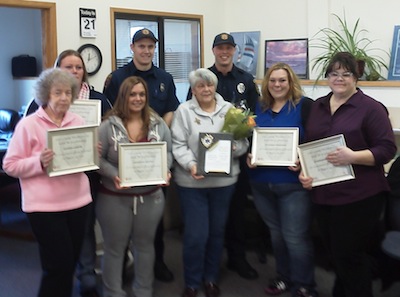By Sharyn L. Decker
Lewis County Sirens news reporter
CHEHALIS – She’s a mother of six, grandmother to six and great grandmother to three more.
She bowls in a league, and belongs to the Southwest Washington Fair Association’s booster club.
For Thanksgiving, she gives thanks for her family, friends and co-workers.
Kathryn Estep, 69, born and raised in Chehalis works part time at a call center with a group of women who saved her life.
“A co-worker said Kathryn dropped a pen,” Paramedic Steve Busz said. “I guess Kathryn was slumped in her chair.”
Her heart had stopped pumping, according to Busz.
Lyla Spears, the supervisor at Service Bureau then on Bishop Road, recalled what she and her co-workers did next after one of them sitting near Estep, Donna Lavigne, hollered out, “She needs help.”
Spears said she came out from the back room, took one look at Estep and knew right away what was going on; she’d witnessed her sister take her last breath not long before.
Spears checked her pulse and helped move Estep out of the chair onto the floor, she said.
“Jennifer’s the one who gave chest compressions the whole time, Charlene did mouth to mouth,” she said.
Carmen Lyon called 911 and stayed on the phone with them, while Rhoda Mendoza waited outside to flag down the ambulance, she recounted.
“Everybody just fell together, like we knew what we were doing,” Spears said.
What happened in August is something Estep has only heard about from others.
“I went to work that day and the next thing I knew, I woke up in the hospital,” she said.
Estep said apparently the condition that struck her is something that runs in her family, but her doctor has said her heart is fine now. She got back to work in October, and began bowling again earlier this month.
“I had no idea Jennifer knew the CPR like she did,” Estep said. “But they all did. I’m so grateful, words can’t express. They’re all angels.”
Paramedic Busz sees the events of that day as something that others could learn from, and easily mean more lives being saved.
“Everything that happened that day was perfect,” he said.
The lesson, for Busz, is something the American Heart Association calls the chain of survival, five steps that can mean the difference between life and death when it comes to cardiac arrest.
Overall, only 8 percent of cardiac arrest patients survive, according to AHA statistics.
“It’s not something we get to see all that often,” he said.
But effective Cardio Pulmonary Resuscitation provided immediately can triple a person’s chances for survival, Busz said.
What’s important for non-medics to know, is a good portion of what needs to be done can be implemented even before emergency responders arrive, Busz says.
The first is immediate recognition of cardiac arrest and calling 911 and the second is right away starting CPR with the emphasis on chest compressions, according to Busz.
“All of the links in Kathryn’s case were met that day, as you can see, it proved itself to work,” he said.
Busz and Firefighter-EMT Greg Folwell work for Lewis County Fire District 6, protecting the rural areas surrounding Chehalis and a population of about 8,000.
When they arrived at mid-morning that day to Service Bureau’s office, the pair took over CPR, put Estep on a heart monitor, defibrillated her and administered other interventions. Medics from AMR joined them.
They got a pulse back on Estep before she was even transported, he said. She was taken to Providence Centralia Hospital and then transferred to Providence St. Peter Hospital in Olympia where she stayed for a week.
The third link in AHA’s chain of life is the “shock” which in Estep’s case was done by the medics, but which can also be handled when workplaces have on site Automated External Defibrillators, according to Busz. He’d like to see more of them out there, he said.
The fourth step is effective advanced life support by professionals like the medics and the final step is the post cardiac arrest care provided at a hospital.
Busz said its his understanding Estep is doing phenomenally well.
Busz said they’d like to increase the 8 percent survival rate to 15 percent, to 25 percent or more and it seems possible, if only more folks reacted the way the six women did that day at Service Bureau’s office.
The message he wants to share with Estep’s story is, saving lives of those whose hearts stop begins with ordinary people.
“Sixty percent of everything that can be done to increase the odds of survival can be done prior to us getting there,” he said.
The other message: Take CPR training, Busz says.
“Call your fire department, if they don’t do it, they know someone who does,” he said.

Kathryn Estep is surrounded by co-workers and two of the medics who helped get her heart restarted after a sudden cardiac arrest.
Tags: By Sharyn L. Decker, news reporter
Love that lady! She is surrounded by wonderful people.
God Bless!